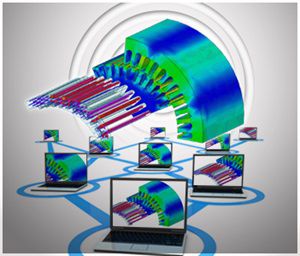-
United States -
United Kingdom -
India -
France -
Deutschland -
Italia -
日本 -
대한민국 -
中国 -
台灣
-
-
產品系列
查看所有產品Ansys致力於為當今的學生打下成功的基礎,通過向學生提供免費的模擬工程軟體。
-
ANSYS BLOG
February 16, 2016
10x Faster Transient Electromagnetic Field Simulation
“I feel the need. The need for speed!” is a famous line from the movie Top Gun. Designers of electric motors, power transformers, planar transformers, and actuators — or anyone that regularly runs transient electromagnetic field simulations — can relate to that phrase. Transient electromagnetic field simulation is a powerful, accurate method to solve EM problems in the time domain, but the process is painfully slow even with today’s fastest computers. Thus, EM transient simulations often are relegated to the verification stage rather than the design stage of the device. With Ansys Maxwell in Ansys 17.0, you can now channel your inner Tom Cruise — Ansys delivers on your need for speed!
Transient electromagnetic field simulation allows analysis of dynamic systems with nonlinear materials and permanent magnets under a variety of conditions, employing sinusoidal — or practically any pulsed waveform — excitation. The process requires calculation at many sequential time steps of saturation, eddy currents, slotting effects, and rotor movement in time and space. The huge computational undertaking of characterizing an electric machine, of any kind, at steady-state operation can take days or weeks to complete. This limits the number of design points that engineers can acquire in a reasonable amount of time to make critical design decisions.
To overcome these limits, new patent-pending technology in Maxwell delivers a minimum 10x speed and 10x capacity improvement for transient electromagnetic field simulations. Simulations that previously required weeks of computation time can now be completed in a matter of hours. Several groundbreaking technologies working in tandem deliver this unprecedented speed and capacity improvement. The key technology is a new algorithm that enables engineers to solve time steps simultaneously as opposed to sequentially.
The real power comes when we combine Maxwell’s new time decomposition method with high-performance computing (HPC) hardware. This can be deployed on a single multicore machine, multiple-network connected workstations, cluster or cloud. Ansys Maxwell 17.0 fully leverages Hybrid High Performance Computing (HPC) architectures. The time steps can be distributed to multiple nodes where multiple cores are engaged to accelerate the computation time even more. These computational speed and capacity breakthroughs, which are only available in Ansys Maxwell with HPC, make transient electromagnetic field simulation a viable design tool instead of a final verification tool. Critical transient behavior, like flux weakening operations under certain load and fault conditions, can be assessed during early design stages, not just final design verification, reducing the risk of project delays and late stage design changes.
There are many more advances available in Maxwell 17.0, including integration into the Ansys Electronics Desktop, advances in material modeling, design automation, Hardware in the Loop (HiL) and Software in the Loop (SiL). It is our most powerful release of Maxwell to date. I invite you to explore the information and benchmarks available in our release material to discover the competitive advantage Maxwell 17.0 can deliver to your organization.












